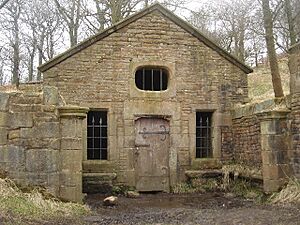Hollinshead Hall facts for kids
Quick facts for kids Hollinshead Hall |
|
|---|---|

The ruins of Hollinshead Hall
|
|
| General information | |
| Location | Tockholes, Lancashire |
| Country | England |
| Coordinates | 53°40′32″N 2°30′38″W / 53.6756°N 2.5105°W |
Hollinshead Hall was once a large country house, also known as a manor house. It was located near the village of Tockholes in Lancashire, England. Today, only ruins of the hall remain.
It's not fully clear if Hollinshead Hall was the main manor house for Tockholes village. It might have been its own separate manor. The ruins are about 2 miles (3.2 km) south of Tockholes.
At the site, you can see parts of the hall and gardens from the late 1700s. There are also remains of a barn and stables. Further south, you'll find what's left of a farmhouse and other farm buildings. The only structure still standing is a well house, found at the southeast side of the old garden.
Contents
What's in a Name? The Story of Hollinshead Hall
The name "Hollinshead Hall" likely comes from the Hollinshead family. They are thought to have built the hall before the 1300s. It might also be named after the area, which was called the Manor of Hollinshead.
The earliest mention of Hollinshead Hall is from 1311. However, it's possible the hall existed even before then.
One idea is that the name "Hollinshead" doesn't come from a family at all. Instead, it might be a changed version of "Holy Head." This was an early name for the manor in the 1300s. "Holy Head" could have come from an even older Saxon name. This older name might have described the area's hills and a special spring-fed Holy well. The name Tockholes itself also has Saxon or Viking roots. There's strong proof that people settled here a very long time ago.
The History of Hollinshead Hall
Who Owned Hollinshead Hall?
Over many years, several important families from Lancashire owned this manor.
The first record of Hollinshead Hall is in a document from the 1300s. It states that in 1311, John de Radcliffe owned "100 Acres in the place called Holinhead, In Tokholes." He was from the well-known de Radcliffe family of Lancashire.
By 1380, the manor, then called "le Holyhead In Tokholes," included a main house (called a messuage). It also had 6 acres (24,000 m²) of land for growing crops. There were 20 acres (81,000 m²) of meadow and 60 acres (240,000 m²) of pasture for animals.
In 1498, Sir Alexander de Hoghton owned the manor. He was part of the noble Hoghton Family from Hoghton Tower.
By 1641, the hall technically belonged to Charles I of England. Later, in 1662, it was rented to Edward Warren. He paid 2 shillings each year for "The Hollinhead." The Warren family likely kept the hall until 1761.
Changes in the 1700s and 1800s
In 1761, George Warren passed the hall to a group of people called trustees. They then sold it to a man named John Hollinshead. It was just a coincidence that his family name was the same as the hall's name. His family line was very old, going back to the time of Henry III of England.
According to a writer from the 1800s, John Hollinshead made big changes. In 1776, he tore down most of the original hall. He then rebuilt it in a new style. The ruins you see today are from this rebuilt hall.
John Hollinshead died in 1802. He left his property to his cousin, William Brock. William then became William Brock Hollinshead. He later passed the estate to his nephew, Laurence Brock Hollinshead of Chorley.
At this time, the Brock Hollinsheads did not live in the hall themselves. They rented it out to others. In 1803, Edmund Charnley was living there as a tenant. Laurence Brock Hollinshead owned the hall until 1845. However, he sold the land around the hall in 1838. It was bought by Mr. Eccles Shorrock, a famous mill owner from Darwen. Shorrock then bought the hall itself in 1845.
Even though the property was sold, the family name and title continued. Laurence Brock Hollinshead married three times. This created connections with other important families.
The Landscape Around the Hall
Hollinshead Hall sits about 900 feet (274 meters) above sea level. It is on the eastern side of a moorland path. This path runs from the flat lands of Lancashire near Bolton, north towards Preston. The hall was built in a somewhat protected spot, in a hollow facing west.
Today, large tree plantations in Tockholes help protect the site. These trees block the strong winds that blow across the open areas of Anglezarke and Darwen Moors. These plantations are now part of a United Utilities water catchment area. This means they help collect water for public use.
The original hall was very large. But in 1776, John Hollinshead had a big part of it torn down. He then rebuilt it to be smaller. During the early 1800s, the Brock-Hollinshead family owned the hall. They were a very old family from Lancashire.
In 1845, Eccles Shorrock, the mill owner from Darwen, bought the hall. By the end of the 1800s, the buildings were falling apart. They were eventually torn down. This happened when the Liverpool Corporation Waterworks bought the surrounding land. They needed the land to collect water. Much of the stone from the hall was used to build walls in the area. It was also used to build some cottages in Belmont village, which is about 2 miles (3 km) south.
Very little of the hall remains today. The only part still standing is The Well House. It covers a spring that feeds two stone troughs.


